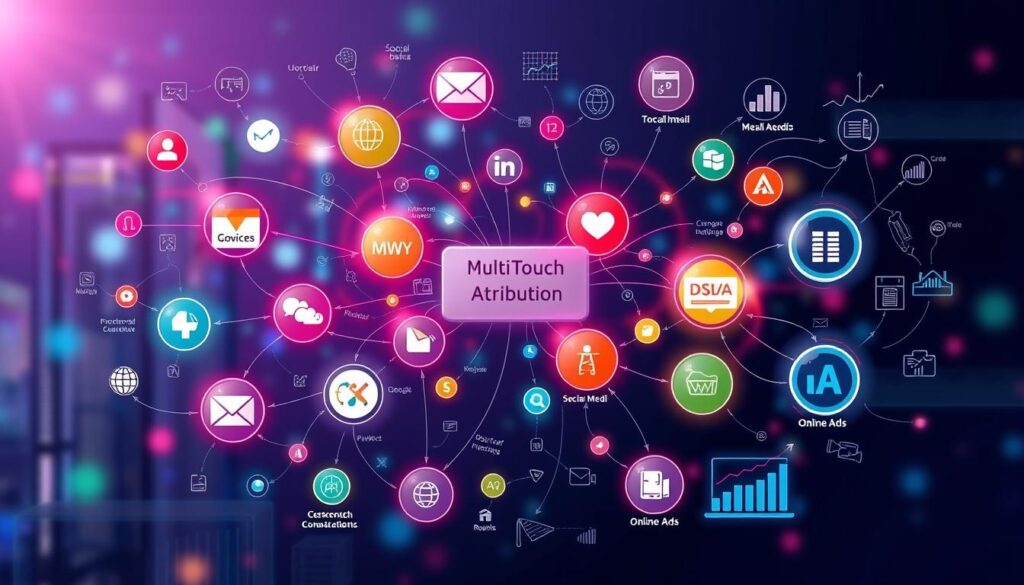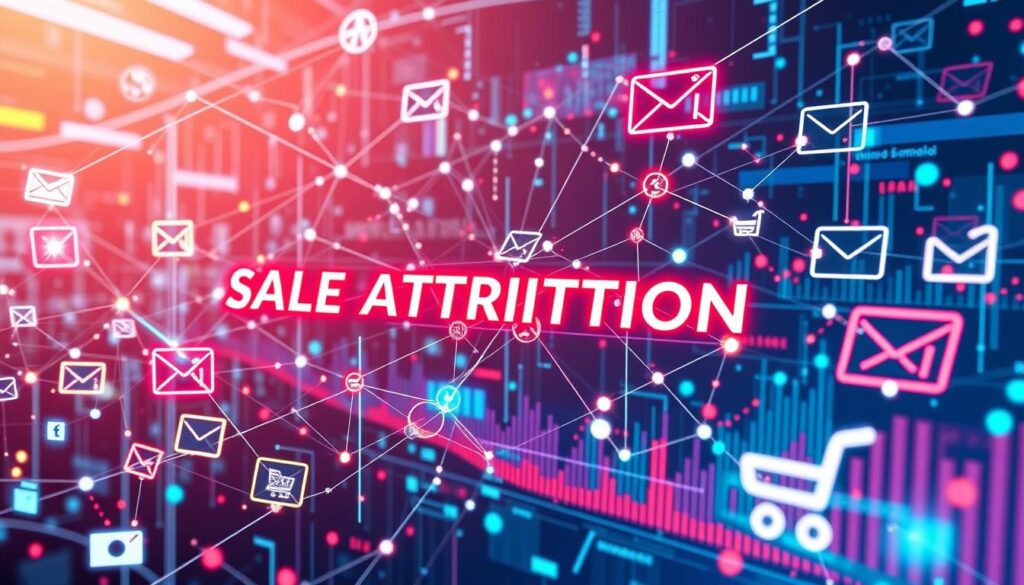The marketing analytics sphere is fast changing. It has gone from simple data monitoring to optimizing sales attribution with machine learning. Now, machine learning-powered sales attribution models are vital. They let businesses break down complex customer journey paths to conversion. This move to advanced analytics for sales attribution gives marketers detailed insights. It improves ROI measurement and aids in crafting informed marketing strategies.
Machine learning digs into big datasets to value each customer interaction. This upgrades old models, giving a full view of the customer journey. With this rich insight, marketers can adjust their spending wisely. They focus on the tactics and interactions that truly bring sales. Thus, companies using these advanced machine-learning methods are raising the bar for campaign success and sales growth.
Key Takeaways
- Machine learning models transcend traditional sales attribution, improving accuracy in ROI determination.
- Optimizing marketing budget allocation becomes more effective with machine learning’s predictive capabilities.
- Data integration from diverse sources is paramount for machine learning models to provide actionable insights.
- Advanced analytics for sales attribution facilitates real-time adjustments and strategy optimization.
- Machine learning algorithms are indispensable in evaluating multi-channel marketing efforts and resource distribution.
- Data-Driven Attribution (DDA) models dynamically calibrate credit allocation, ensuring an unbiased assessment of marketing touchpoints.
- Understanding both advantages and disadvantages of Data-Driven Attribution encourages informed decision-making.
Understanding Sales Attribution Models
In today’s world, knowing how sales attribution models affect marketing is key. Sales attribution shines a light on key sales drivers, helping to tweak marketing campaigns. With machine learning, analyzing complex data to improve sales tactics is now possible.
Definition and Importance of Sales Attribution
Sales attribution is about figuring out what marketing efforts led to a sale. It shows which parts of the customer journey are vital in making decisions. This helps in using marketing money wisely and increasing ROI.
Types of Sales Attribution Models
There are mainly two kinds of sales attribution models: single-touch and multi-touch. Single-touch models give all credit to the first or last interaction. While good for quick sales, they miss out on other important interactions. Multi-touch models, however, spread the credit around, covering the whole buyer’s journey. These models include linear, time decay, U-shaped, and algorithmic, each useful in different scenarios.
Below is a table outlining the key characteristics of some prevalent sales attribution models:
| Model Type | Definition | Best Suited for |
|---|---|---|
| First-Touch | Assigns 100% of the conversion credit to the first customer interaction. | Quick decision-making processes. |
| Last-Touch | Assigns 100% of the conversion credit to the last customer interaction before a purchase. | Campaigns aimed at immediate conversion. |
| Linear | Distributes credit equally across all touchpoints. | Businesses wanting a simple yet inclusive approach. |
| Time Decay | Attributes more credit to touchpoints closer to the time of conversion. | Campaigns with multiple interactions over shorter periods. |
| U-Shaped | Gives most credit to the first and last touchpoints, distributing the remaining credit evenly among other touchpoints. | Businesses valuing initial and closing interactions. |
| Algorithmic | Leverages machine learning to dynamically assign credit to touchpoints based on their influence on the conversion. | Complex buyer journeys with extensive data. |
How Attribution Models Impact Sales Strategy
Effective sales attribution models reveal the top and bottom performing channels. This guides the redistribution of budgets to boost marketing and sales. Using machine learning refines this by forecasting touchpoints’ impacts, enhancing marketing ROI.
This use of single-touch or multi-touch models with machine learning improves decision-making. It helps in better resource allocation, fostering business growth.

The Role of Machine Learning in Attribution
The digital marketing world is getting more complex. This makes strong, AI-driven sales attribution models key. Machine learning (ML) is leading this tech update. It changes how we analyze data and make decisions.
Enhancing Data Analysis with Algorithms
ML algorithms let businesses quickly go through lots of data. This not only makes Multitouch Attribution (MTA) models better. It also makes predictive modeling for sales attribution more exact and relevant. ML goes deeper than simple linear or last-touch models. It sees complex patterns and connections across marketing channels.
Predictive Insights for Sales Performance
Predictive modeling helps businesses guess consumer actions early. Advanced ML models offer deep insights into how customers make decisions. These insights are more detailed than traditional methods can provide. They help companies predict trends and change their marketing to suit what customers want next.
Real-Time Attribution Adjustments
Adding ML to sales attribution means you can update in real time. This keeps models up-to-date with the latest market trends. ML algorithms look at new data constantly. This lets businesses quickly change their marketing plans. Such fast changes make campaigns more effective, increase ROI, and build stronger customer relationships.
To wrap up, using machine learning in sales attribution improves analysis and boosts predictive accuracy and flexibility. Companies using these advanced ML techniques are ahead in the fast-changing digital market.
Key Machine Learning Techniques for Attribution
In today’s world, using machine learning algorithms for sales attribution is key. They allow for detailed tracking and smarter decisions. Through understanding customer actions and choices, they boost marketing plans and ROI.

Logistic Regression is crucial for seeing if a lead will result in a sale. It helps companies figure out which digital actions lead to purchases. This understanding impacts the purchaser’s decisions greatly.
Logistic Regression and Its Applications
Logistic regression links customer actions to outcomes, like buying something. It looks at different ways customers engage, from emails to social media. This is vital for machine learning sales attribution models aiming to better target customers.
Decision Trees in Sales Attribution
Decision trees build on logistic regression by showing decision paths. Marketers learn which actions most likely result in a sale. When combined with machine learning algorithms for sales attribution, it’s clear how different engagements influence sales.
Neural Networks for Complex Attribution Scenarios
Neural networks tackle complicated patterns in sales and customer behavior. They’re great for big data and complex cases, like multi-channel marketing. They offer in-depth analysis for advanced analytics for sales attribution.
Businesses are moving towards data-driven strategies with these tools. This shift not only makes sales attribution more precise but also boosts marketing success. It makes sure money spent is directly linked to sales outcomes.
Implementing Machine Learning Sales Attribution Models
The digital marketing world is changing fast. Machine learning in marketing attribution is now key for companies. It helps pinpoint what marketing moves make sales happen. Machine learning digs through complex data and spots patterns that affect what customers do. This gives a clearer insight into how well marketing works.
Steps for Integration into Existing Systems
First off, check if your current data setup can work with new tech. You need the right data, then clean and add to it. After that, pick and use the best machine learning model for sales. This includes technical changes and teaching your team about the new system. Everyone needs to know how to use it well.
Tools and Technologies to Consider
Choosing the right tools is a big deal. Look for tech that can process lots of complex data. Cloud-based analytics platforms are good because they handle big data well. Also consider machine learning tools like TensorFlow or Scikit-learn. They have smart algorithms for better sales data analysis.
Best Practices for Data Collection and Analysis
To do well, you must collect data the right way and keep it clean. Make sure to follow privacy laws and always look for ways to do better. Good data and correct labels are the base for machine learning. By always improving your models, your marketing choices get smarter. This leads to better results.
Using advanced machine learning helps companies stay ahead. It makes tracking marketing ROI more precise. Each time you upgrade your machine learning, your marketing gets better. This drives growth for your business.
Measuring the Effectiveness of Machine Learning Attribution
The digital world is quickly adopting machine learning sales attribution models. These models are changing how we see consumer interactions. They help us understand the true impact of our marketing efforts.
Key Performance Indicators for Attribution Models
It’s important to track the right numbers to see if optimizing sales attribution with machine learning is working. We look at more than just basic stats like conversion rate. ROI-focused measures, like Return on Ad Spend (ROAS), show us the money side of our sales strategies. These indicators help us check the accuracy of AI-powered sales attribution. They show us how well we’re reaching customers at every step.
Iterating on Your Attribution Strategy
The world of digital marketing keeps changing. So, our attribution models must evolve as well. Machine learning in marketing attribution allows for ongoing improvements. With AI, our tools learn and adapt to new data and trends. This means we can constantly fine-tune our strategies to get better insights, even as the market changes.
Case Studies of Successful Implementations
Looking at success stories, we see the big impact of machine learning sales attribution models. By checking out different case studies, companies see real examples of better campaign ROI. These stories move us beyond simple models to more complex ones. Models like Linear, Time-Decay, and Data-Driven Attribution get better with machine learning. They help us understand marketing impact in detail, boosting our effectiveness.
FAQ
What is the significance of implementing machine learning models in sales attribution?
Machine learning models make sales attribution better. They let us understand each touchpoint’s role in the customer’s journey. This helps in spending budgets wisely, making marketing better, and increasing ROI.
How do machine learning sales attribution models differ from traditional attribution models?
Machine learning models are smarter than traditional ones. They can learn and analyze big data to find unique insights about customer behavior. This happens in real time, making them really effective.
What are single-touch and multi-touch sales attribution models?
Single-touch models credit the first or last customer interaction. They’re good for simple sales. Multi-touch models, on the other hand, spread credit across many interactions. This is great for understanding complex customer journeys in longer sales.
Why is predictive modeling important in sales attribution?
Predictive modeling forecasts future buying actions. It finds potential sales drivers. This lets businesses stay ahead and meet customer needs in a fast-changing market.
What role does logistic regression play in sales attribution?
Logistic regression helps figure out the chances of a customer making a purchase. It works well for sales attribution because it can make predictions from yes-or-no outcomes.
How do decision trees and neural networks enhance sales attribution models?
Decision trees simplify complex decision-making. They show key customer interaction points. Neural networks, however, deal with complicated data patterns. They bring deep analysis and predictions, making sales models very powerful.
What considerations should be made when integrating machine learning sales attribution models into existing systems?
When adding machine learning models, check your data setup first. Pick the right algorithms and ensure data flows without issues. It’s key to have flexible systems that can grow with you.
What technologies are typically used alongside machine learning sales attribution models?
We often see cloud analytics, machine learning tools, and big data processors. They handle complex data and attribution well, giving deeper insights.
What are some best practices in data collection and analysis for sales attribution?
Key practices include keeping data clean, respecting privacy, and constantly checking data. Doing these well supports the reliability of machine learning in sales attribution.
How do you measure the success of machine learning sales attribution models?
Success is seen through key metrics like conversion rates and ad spending returns. These show if the attribution model truly helps understand sales better.
Why must attribution strategies be iteratively refined?
Strategies need to evolve with new data and market changes. Machine learning helps update these models quickly, keeping insights fresh and actionable.
Where can I find case studies on successful machine learning sales attribution implementations?
Look for case studies in industry magazines, online platforms, or at events. They show how machine learning boosts marketing outcomes and ROI.



